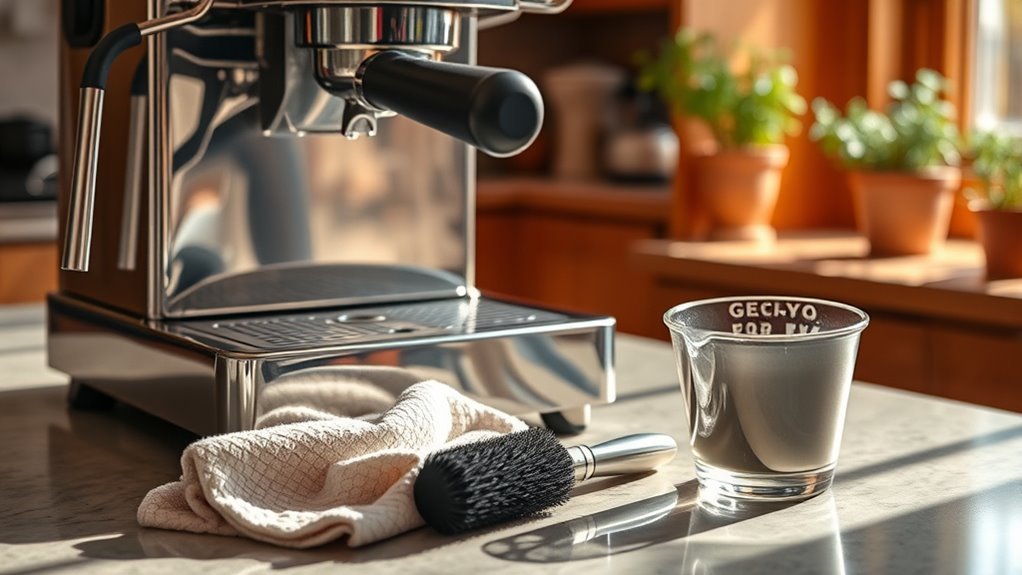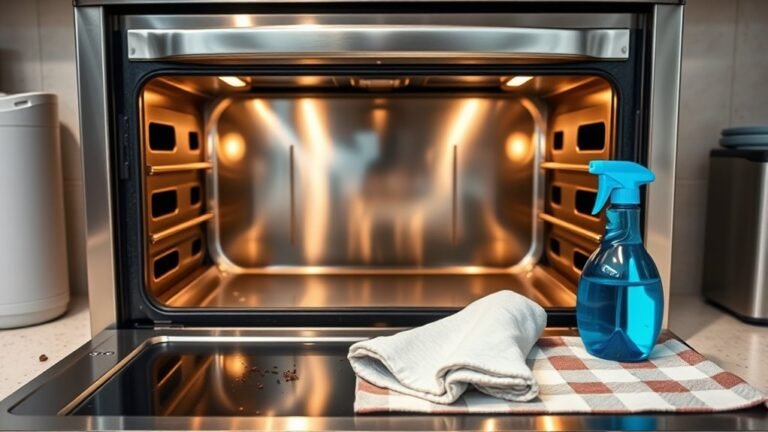Tips for Cleaning a Home Espresso Machine
To keep your home espresso machine brewing great coffee, clean it daily by wiping the steam wand, flushing the group head, and rinsing the portafilter. Use the right brushes and safe cleaners, and descale regularly to prevent mineral buildup. Don’t forget weekly deep cleans, including backflushing and soaking parts. Consistent care prevents clogs and maintains flavor, ensuring your machine lasts longer. If you want to master your espresso routine, there’s plenty more to explore.
Understanding the Importance of Regular Cleaning

Although it might seem like an extra chore, regular cleaning is essential to keep your home espresso machine working smoothly and producing great-tasting coffee. When you stick to a consistent cleaning frequency, you prevent buildup that can clog your machine and ruin the flavor of your espresso. Proper espresso maintenance guarantees your equipment lasts longer, saving you from costly repairs or replacements. Plus, a clean machine means your coffee tastes fresh every time, giving you the freedom to enjoy café-quality espresso at home. By prioritizing this simple routine, you’re investing in both your machine’s health and your daily coffee experience. Embrace the habit, and you’ll find espresso maintenance isn’t a burden but a key to revealing your best brew.
Gathering the Right Cleaning Supplies
Before you start cleaning, make sure you have the right tools on hand, like brushes and cloths designed for espresso machines. You’ll also need recommended cleaning agents that are safe and effective. Don’t forget safety gear, such as gloves, to protect your hands during the process.
Essential Cleaning Tools
A few essential tools can make cleaning your home espresso machine much easier and more effective. Choosing the right tools depends on your cleaning frequency and tool selection preferences. Regular cleaning demands durable brushes and scrapers, while occasional deep cleans might require specialized gear.
| Tool | Purpose | Recommended Cleaning Frequency |
|---|---|---|
| Group head brush | Cleans coffee grounds | After every use |
| Microfiber cloth | Wipes exterior surfaces | Daily |
| Blind filter | Backflush the machine | Weekly |
Having these tools at your disposal gives you the freedom to maintain your espresso machine efficiently without hassle. Proper tool selection guarantees you’re never stuck, helping you enjoy fresh espresso with less effort.
Recommended Cleaning Agents
Choosing the right cleaning agents is essential to keep your espresso machine running smoothly and tasting great. You want products that effectively remove coffee oils and residue without damaging delicate parts. Natural cleaning solutions, like vinegar or baking soda, offer a gentle, eco-friendly option that’s easy to find and safe to use. They’re perfect if you prefer a chemical-free approach and value freedom from harsh substances.
On the other hand, commercial cleaning agents designed specifically for espresso machines deliver powerful results and often include descaling properties. These agents are formulated to tackle stubborn buildup quickly and efficiently. Whichever you choose, make certain it’s compatible with your machine to avoid voiding warranties or causing damage. By selecting the right cleaning supplies, you guarantee your espresso experience stays fresh and flavorful every time.
Safety Gear Essentials
Once you’ve picked the right cleaning agents, it’s important to gather the proper safety gear to protect yourself during the process. Wearing gloves protection is a must to shield your hands from harsh chemicals. Eye protection is equally essential to prevent splashes from irritating or damaging your eyes. Don’t skip these simple steps if you want a safe, carefree cleaning experience.
| Safety Gear | Purpose |
|---|---|
| Gloves | Protects hands from chemicals |
| Goggles | Shields eyes from splashes |
| Apron | Keeps clothes safe from spills |
| Ventilation Mask | Prevents inhalation of fumes |
Equipped with these essentials, you’re free to clean your espresso machine effectively and safely.
Daily Cleaning Routine for Your Espresso Machine
Even if you use your espresso machine daily, keeping it clean should never be overlooked. A simple daily cleaning routine is key to espresso maintenance and guarantees machine longevity. After each use, quickly wipe down the exterior and steam wand to prevent milk residue buildup. Flush the group head with hot water to clear leftover coffee grounds. Empty and rinse the drip tray and water reservoir regularly to avoid stale odors or mold. These small steps free you from costly repairs and preserve your machine’s performance, letting you enjoy fresh espresso without hassle. By committing to this routine, you protect your investment and keep your coffee ritual smooth and satisfying. It’s the freedom to savor great espresso every day without interruptions.
How to Clean the Portafilter and Basket

You’ll want to clean your portafilter and basket every day to prevent coffee residue from building up. Using deep cleaning methods occasionally helps keep them in top condition. Let’s go over the best steps to keep these parts spotless and working well.
Daily Cleaning Routine
Although cleaning the portafilter and basket might seem tedious, doing it daily is essential for great-tasting espresso and the machine’s longevity. Staying consistent with this daily upkeep is key to easy espresso machine maintenance and preserving your freedom to enjoy perfect shots anytime.
Here’s a simple daily cleaning routine for your portafilter and basket:
| Step | Action |
|---|---|
| 1. Remove | Detach portafilter and basket |
| 2. Rinse | Use warm water to wash off grounds |
| 3. Scrub | Gently clean with a brush |
| 4. Dry | Wipe or air dry before use |
Stick to this routine, and your espresso machine stays in top shape, letting you savor every cup without hassle.
Deep Cleaning Methods
Since daily cleaning only removes surface residue, deep cleaning your portafilter and basket regularly is essential to eliminate stubborn coffee oils and buildup that affect flavor and machine performance. Aim for a deep cleaning frequency of at least once a week if you use your espresso machine daily. Start by soaking these parts in a solution of warm water and a specialized espresso machine cleaner or a mild detergent. Use a soft brush to scrub away any remaining residues, focusing on the tiny holes in the basket. Rinse thoroughly with clean water to avoid any chemical taste. These deep cleaning techniques will free your espresso machine from hidden grime, ensuring each shot of coffee tastes fresh and vibrant, while giving you the freedom to enjoy your brew without compromise.
Preventing Coffee Residue Build-up
While regular deep cleaning is essential, preventing coffee residue build-up starts with properly cleaning your portafilter and basket after each use. Coffee oils can quickly accumulate, affecting flavor and machine performance. Right after brewing, rinse the portafilter and basket under hot water to wash away leftover grounds and oils. Use a soft brush or cloth to scrub stubborn spots gently. Maintaining a consistent cleaning frequency is key—don’t let residue harden over time. Once a week, soak these parts in a solution designed to break down coffee oils for a thorough cleanse. By sticking to this routine, you’ll keep your espresso tasting fresh and your machine running smoothly, giving you the freedom to enjoy perfect shots without hassle.
Descaling Your Machine: When and How

If you want your espresso machine to keep brewing great-tasting coffee, descaling it regularly is essential. Hard water leaves mineral deposits that clog your machine, affecting flavor and performance. Pay attention to descaling frequency based on your water hardness and machine use—typically every 1 to 3 months. Using the right descaling solutions is key; opt for those designed for espresso machines to avoid damage. To descale, fill the water reservoir with the solution mixed as directed, run the machine through a brewing cycle without coffee, then rinse thoroughly by running clean water cycles. Staying on top of descaling frees you from poor coffee and costly repairs, letting you enjoy espresso on your terms without interruptions.
Cleaning the Steam Wand Effectively
To keep your steam wand working well, you’ll want to wipe it down daily right after use. For a thorough clean, a deep cleaning process is essential to remove milk residue that builds up inside. Let’s go over how to do both effectively.
Daily Wipe Routine
Every time you finish steaming milk, you should wipe the steam wand immediately to keep it clean and prevent buildup. This simple daily wipe routine is essential for effective espresso machine maintenance and guarantees your machine stays in top shape. Use a damp cloth or dedicated steam wand cleaning brush to remove milk residue right after each use. Don’t forget to purge the wand briefly to clear any milk trapped inside. Maintaining this cleaning frequency saves you time and hassle later, preventing stubborn clogs and unpleasant odors. By sticking to this quick step, you give yourself the freedom to enjoy flawless steam performance every day without worrying about deep cleans after every cup. Consistency here keeps your espresso experience smooth and your machine reliable.
Deep Cleaning Process
Although wiping the steam wand after each use helps, you’ll still need to deep clean it regularly to remove stubborn milk buildup and guarantee peak performance. To do this, soak the steam wand tip in a solution designed for espresso machine maintenance, typically a mixture of warm water and a specialized cleaner. Let it sit for about 15-20 minutes, then use a small brush or pin to clear any remaining residue from the nozzle holes. Rinse thoroughly with clean water afterward. Following this deep cleaning process on a weekly basis, depending on your cleaning frequency, assures your machine stays in top shape and prevents clogging. Staying consistent with this routine not only preserves the freedom to enjoy perfect espresso shots but also extends your machine’s lifespan.
Maintaining the Group Head for Optimal Performance
Since the group head is where water meets coffee grounds, keeping it clean guarantees your espresso tastes fresh and balanced. To achieve peak performance, regular group head maintenance is essential. Here’s how you can stay on top of it:
The group head’s cleanliness ensures every espresso shot is fresh, balanced, and full of flavor.
- Backflush Weekly: Use a blind filter and espresso machine cleaner to remove coffee oils and residues that can clog the group head.
- Clean the Shower Screen: Detach and soak it in a cleaning solution to clear any trapped grounds, ensuring even water distribution.
- Wipe After Each Use: Quickly clean the gasket and group head with a damp cloth to prevent buildup and maintain your machine’s freedom to brew consistently.
Stick to this routine, and your espresso machine will reward you with rich, flavorful shots every time.
Tips for Cleaning the Water Reservoir
Keeping your espresso machine’s water reservoir clean is essential for preventing mineral buildup and ensuring your coffee tastes fresh. To maintain water quality, empty and rinse the reservoir daily with fresh water. Once a week, give it a thorough clean using mild soap and warm water, avoiding harsh chemicals. This simple step keeps your machine running smoothly and your brews tasting clean. Stick to a consistent maintenance schedule—regularly checking for deposits or discoloration helps you catch issues early. If you use hard water, consider filtering it to reduce mineral deposits, extending the lifespan of your machine. By incorporating these habits into your routine, you’ll enjoy espresso that’s always flavorful and a machine that stays in peak condition without hassle.
Using Cleaning Tablets and Solutions Safely
Two key things to remember when using cleaning tablets and solutions are safety and effectiveness. To keep your espresso machine in top shape without risking damage or harm, follow these guidelines:
- Check solution compatibility: Always use cleaning products recommended for your machine model to avoid corrosion or malfunction.
- Stick to the cleaning frequency: Overcleaning can wear parts, while undercleaning leads to buildup. Follow your machine’s maintenance schedule precisely.
- Handle with care: Wear gloves and confirm the area is well-ventilated when applying tablets or solutions, and never mix different cleaners to prevent dangerous reactions.
Troubleshooting Common Cleaning Issues
Even when you follow cleaning instructions closely, you might still encounter issues like residue buildup, unpleasant odors, or poor water flow. Adjusting your cleaning frequency and using effective troubleshooting tips can help you regain control and keep your espresso machine running freely.
| Issue | Cause | Quick Fix |
|---|---|---|
| Residue buildup | Infrequent cleaning | Increase cleaning frequency |
| Unpleasant odors | Stale water or mold | Clean water tank and run cycle |
| Poor water flow | Clogged filters or pipes | Backflush and descale machine |
Stick to a routine, and don’t hesitate to troubleshoot early. Keeping your espresso machine clean is key to your freedom to enjoy great coffee anytime.
Frequently Asked Questions
Can I Use Vinegar Instead of Commercial Descaling Products?
You can use vinegar as a descaling alternative thanks to its natural acidity, which helps break down mineral buildup. Vinegar benefits include being affordable and readily available, giving you freedom from relying on commercial products. However, it’s important to rinse thoroughly afterward to avoid any lingering taste or damage to your machine’s components. While vinegar works well, some prefer specialized descaling products designed specifically for espresso machines for best care.
How Often Should I Replace the Water Filter in My Machine?
Think of your water filter as the heart of your espresso machine, pumping clean water to keep each shot pure. For ideal water filter maintenance, you should stick to a filter replacement frequency of every two to three months, depending on your usage and water hardness. Changing it regularly frees you from build-up and guarantees your espresso tastes just right, giving you the freedom to enjoy every cup without worrying about hidden impurities.
Is It Safe to Clean the Machine With a Dishwasher?
You shouldn’t clean your espresso machine parts in the dishwasher, as dishwasher safety varies by component and can damage delicate parts. Instead, use gentle cleaning materials like warm water and mild detergent to keep everything in top shape. This approach gives you freedom to maintain your machine without risking warped or broken pieces. Always check the manufacturer’s guidelines to know what’s dishwasher-safe and what’s not, so you don’t accidentally harm your machine.
What Are the Signs My Espresso Machine Needs Professional Servicing?
If your espresso machine starts acting like a stubborn mule—making strange noises, leaking, or brewing weak coffee—it’s time to listen up. Ignoring espresso machine issues can chain you to poor coffee days, so sticking to a maintenance schedule is key. When your machine’s performance dips despite regular cleaning, or warning lights flash, don’t hesitate to call a pro. You deserve the freedom of flawless espresso without the hassle.
Can I Use Regular Dish Soap to Clean the Portafilter?
You might be wondering if regular dish soap works for portafilter maintenance. While it’s tempting to use common cleaning materials, dish soap can leave residues that affect your espresso’s taste. It’s better to stick with specialized espresso machine cleaners or mild detergents designed for coffee gear. This way, you keep your portafilter in top shape without compromising flavor, giving you the freedom to enjoy great coffee every time.






